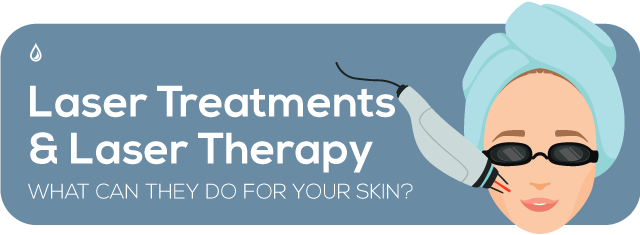
Have you ever rolled out of bed in the morning, looked in the mirror, and wished you could finally get rid of your acne scars or soften those pesky wrinkles?
Everyone deserves to look and feel their best. And today, advancements in laser therapy have made smoothing age lines and removing unwanted marks as easy as a quick dermatology appointment.
Lasers are highly effective in removing moles, warts, or lesions. They can also aid in reducing visible scarring, rejuvenating lax skin, and breaking up unwanted tattoos. Safe to say, if you have a skin concern, we probably have a laser treatment to help.
So let’s start by asking the obvious questions: Which laser treatment is right for you? What should you know about them before you start planning your treatment?
We sat down with The Dermatology Specialists’ Dr. Dina Began to get a dermatologist’s inside look into laser therapy.
“Lasers can be incredibly effective tools in winning the battle against the appearance of aging skin,” Dr. Began explains. “We maintain a versatile array that can help our patients with a variety of skin concerns.”
When she says variety, she isn’t overstating. Just a few of the conditions that lasers can play a crucial role in treating include acne, acne scars, rosacea, telangiectasias, angiomas, varicose veins, fine lines, wrinkles, sagging and lax skin, unwanted tattoos, unwanted hair, unwanted lentigines (liver spots) and ephelides (freckles), and melasma.
However, Dr. Began stresses that patients should never rush into laser therapy without first sitting down for a thorough consultation with their dermatologist.
“The first step in any laser procedure is knowing what the condition is,” she stresses. “Your dermatologist needs to know how best to approach the treatment, decide whether the technology makes sense from a pathophysiological standpoint, and understand how it can positively affect the appearance of the skin.”
Another major consideration that dermatologists face, Dr. Began says, is figuring out which laser would most benefit the case at hand. As she puts the matter: “You would not hit a screw with a hammer or a nail with a wrench.”

Like household tools, different lasers have different applications. According to Dr. Began, she regularly uses five different varieties in her work with patients. Let’s check them out.
Clear + Brilliant
This laser is often referred to as a “mini-fraxel.” The nickname stems from its tiny area of impact; when used, the pulsating beams of light from a Clear + Brilliant laser creates millions of microscopic treatment zones in a patient’s upper skin layers. This effectively exfoliates the skin and, over time, generates younger-looking skin in treated areas.
This effect, Dr. Began explains, is why the Clear + Brilliant Laser has its name. “This laser can be used to help patients achieve a naturally radiant glow, an improvement in brown pigmentation, and ultra-soft skin texture. Thus, their skin looks clear and brilliant!”
Pulse Dye Laser or “V Beam”
The Pulse Dye Laser is widely considered to be the gold standard for treating visible blood vessels. When the energy produced by this laser is absorbed, it heats blood cells within a target area and causes thermal damage in the tube housing those blood cells — the blood vessel. The vessels then break down and are reabsorbed by the body.
What, then, can the Pulse Dye Laser help patients address?
“The Pulse Dye Laser is considered the go-to laser for vascular lesions and conditions that create aberrances to the vasculature,” Dr. Began says. “It’s often helpful in treating rosacea, acne, acne scars, scars, and stretch marks, just to name a few.”
Intense Pulsed Light (IPL)
This technology applies an intense, visible, broad-spectrum pulse of light to a targeted area of a patient’s skin. Specific UV wavelengths are selectively filtered out so that the resulting light is within a spectral range that can target certain structures and chromophores — think melanin in hair or oxyhemoglobin in blood vessels. Like the Pulse Dye Laser, an IPL then uses heat to destroy targeted blood vessels and allow for reabsorption into the body.
“Specific filters can be used to match certain chromophores and ensure that specific targets are destroyed,” Dr. Began explains.
Dermatologists often use IPL to treat acne and rosacea, as well as remove hair or dark spots caused by sun damage.
Sandstone’s Fractional CO2 Laser
This laser is widely considered to be the gold standard for reducing lines, wrinkles, tightening collagen, and reducing pigmentation. When used, it creates heated micro-ablative columns within the deeper dermis that are surrounded by similar columns of unaffected tissue. This approach allows for a unique pattern of repair and is typically used to tighten collagen, reduce pigment, and address unwanted lines and wrinkles.
PicoSure
When it comes to speed, the PicoSure knocks most other lasers out of the park. This technology is relatively new; it uses laser pulses that are one-trillionth of a second in length. Because of this quality, Dr. Began notes, the PicoSure has become dermatologists’ go-to laser for tattoo removal.
“Ink has nowhere to escape from the intensity of this laser,” she explains. “When it hits, it does so with enough speed and force that the tattoo ink shatters into tiny particles that can then be eliminated by the body.”
Besides tattoo removal, the PicoSure can also be used to treat unwanted pigmented spots, melasma, and acne scarring.
The capabilities that these lasers offer are as incredible as they are varied. However, Dr. Began stresses that a patient should always consult with their dermatologist before they commit to laser treatments.
While lasers hold a tremendous amount of potential to help dermatology patients, they aren’t a one-size-fits-all treatment or risk-free solution.
According to Dr. Began, the risks for laser therapy include but are not limited to: increased hair growth, bruising, numbness, tingling, soreness, itching, herpes simplex virus activation, burns, blisters, scabbing, crusting, hyperpigmentation, scarring, temporary nerve damage, discoloration, and skin textural changes.
“Every patient and situation is unique,” Dr. Began stresses. “Each laser and procedure will carry its own set of risks. Patients need to sit down with their dermatologists to thoroughly discuss risks and precautions before treatment.”
As with most dermatological procedures, patients need to go to an extra effort to protect their skin after undergoing laser therapy.
“As dermatologists, we recommend sun protection year-round,” Dr. Began says. “Some lasers should be avoided if you have recently had sufficient sun exposure, and you need to make sure that you are fully protected after you undergo laser treatments.”
The best solution, Dr. Began says, is to connect with your care provider about the dos and don’ts of treatment.
“Protect the benefits of laser treatment. Talking with a board-certified dermatologist about pre- and post-procedure care should be a must — regardless of whether you’re new to laser treatment or had it done several times!”
Want more information on what laser treatments can do to brighten your complexion? Set up an appointment with one of our specialists! Your skin will thank you for it.
 Dina Began, MD is a board-certified dermatologist at The Dermatology Specialists. Named a Castle Connolly Top Doctor, Dr. Began holds the distinction of being part of a small group of dermatologists in the United States to be certified in both dermatology and internal medicine. She earned the Special Recognition Award from the Albert Einstein College of Medicine Unified Division of Dermatology for outstanding mentorship of dermatology residents, medical students and colleagues.
Dina Began, MD is a board-certified dermatologist at The Dermatology Specialists. Named a Castle Connolly Top Doctor, Dr. Began holds the distinction of being part of a small group of dermatologists in the United States to be certified in both dermatology and internal medicine. She earned the Special Recognition Award from the Albert Einstein College of Medicine Unified Division of Dermatology for outstanding mentorship of dermatology residents, medical students and colleagues.